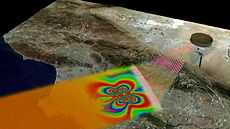Tectonic hazards/Earthquake
< Tectonic hazards| | Subject classification: this is a science resource . |


Earthquake is a violent movement of the rocks in the Earth's crust which creates waves of energy traveling through the Earth. Earthquakes are usually quite brief, but may repeat over a period of time.
There are big earthquakes and small earthquakes. Big earthquakes can take down buildings and cause deaths and injuries. The study of earthquakes is called seismology.[1]
When the earth moves offshore in the ocean, it can cause a tsunami. A tsunami can cause just as much death and destruction as an earthquake. Landslides can happen, too. This is an important part of the Earth's cycle.
Earthquakes are measured using observations from seismometers. The magnitude of an earthquake and the intensity of shaking are measured on a numerical scale. On the scale, 3 or less is scarcely noticeable, and magnitude 7 (or more) causes damage over wide areas.
References
- ↑ Earth Science. Austin, Texas 78746-6487: Holt, Rinehart Winston. 2001. ISBN 0-03-055667-8.
| |||||||